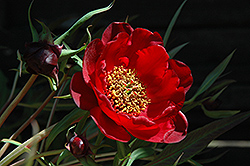Height: 5 feet
Spread: 9 feet
Sunlight:
![]()
![]()
Hardiness Zone: 6b
Description:
A beautiful peony for the garden, with bold flowers in a rich red with prominent yellow stamens, great as an accent in the garden or massed in borders; unlike perennial peonies, remember not to prune this variety
Ornamental Features
Delavay's Tree Peony features bold lightly-scented semi-double scarlet flowers with yellow centers at the ends of the branches from mid to late spring, which emerge from distinctive dark red flower buds. The flowers are excellent for cutting. It has green foliage with red veins. The narrow compound leaves do not develop any appreciable fall colour.
Landscape Attributes
Delavay's Tree Peony is a multi-stemmed deciduous shrub with an upright spreading habit of growth. Its relatively fine texture sets it apart from other landscape plants with less refined foliage.
This is a relatively low maintenance shrub, and should not require much pruning, except when necessary, such as to remove dieback. It is a good choice for attracting butterflies to your yard, but is not particularly attractive to deer who tend to leave it alone in favor of tastier treats. It has no significant negative characteristics.
Delavay's Tree Peony is recommended for the following landscape applications;
- Accent
- Mass Planting
- General Garden Use
Planting & Growing
Delavay's Tree Peony will grow to be about 5 feet tall at maturity, with a spread of 9 feet. It has a low canopy, and is suitable for planting under power lines. It grows at a slow rate, and under ideal conditions can be expected to live for approximately 20 years.
This shrub does best in full sun to partial shade. It does best in average to evenly moist conditions, but will not tolerate standing water. It is not particular as to soil pH, but grows best in rich soils. It is quite intolerant of urban pollution, therefore inner city or urban streetside plantings are best avoided. Consider applying a thick mulch around the root zone in winter to protect it in exposed locations or colder microclimates. This species is not originally from North America.
Disclaimer - This resource is provided for informational purposes only and does NOT reflect current availability. Inventory varies seasonally, so we cannot guarantee that every plant will be in stock at all times - please contact your favourite GardenWorks location directly for current availability. It does not include our entire inventory of plants, so be sure to visit GardenWorks to see varieties that may not be represented on this list.

